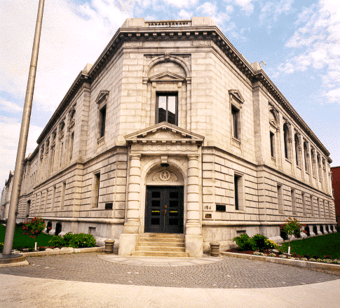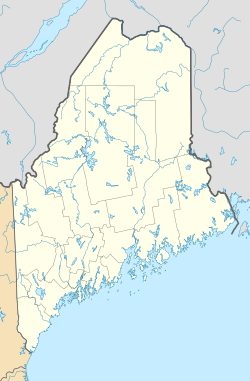Edward T. Gignoux United States Courthouse facts for kids
|
U.S. Courthouse
|
|
|
U.S. Historic district
Contributing property |
|

Edward T. Gignoux U.S. Courthouse
|
|
| Location | 156 Federal St., Portland, Maine |
|---|---|
| Area | 0.7 acres (0.28 ha) |
| Built | 1908 |
| Architect | James Knox Taylor |
| Architectural style | Italian Renaissance Revival |
| Part of | Portland Waterfront (ID74000353) |
| NRHP reference No. | 74000168 |
Quick facts for kids Significant dates |
|
| Added to NRHP | February 12, 1974 |
| Designated CP | May 2, 1974 |
The Edward T. Gignoux U.S. Courthouse is a historic courthouse building. You can find it at 156 Federal Street in Portland, Maine. This building is where the United States District Court for the District of Maine holds its court sessions.
| Top - 0-9 A B C D E F G H I J K L M N O P Q R S T U V W X Y Z |
History of the Courthouse
The U.S. Courthouse in Portland was finished in 1911. It was the very first federal courthouse in Maine. Its grand design and important role made it a special building in Portland. The building was designed by James Knox Taylor. He was the main architect for the U.S. Treasury Department at the time.
Building Design and Location
The courthouse has a unique style called Italian Renaissance Revival. This design fits well with other historic buildings nearby. These include the U.S. Custom House and Portland City Hall. All these buildings are around Lincoln Park. The U.S. Courthouse was added to the National Register of Historic Places in 1974. This list recognizes important historic places in the country.
Construction and Expansion
The area around Lincoln Park became a popular spot for government buildings. In 1908, the government bought land next to the park for the new courthouse. Construction started that same year. The architect, James Knox Taylor, planned a building shaped like a trapezoid. It would have an open space inside, like a courtyard.
The first part of the building was finished in 1911. It was shaped like a "U." Later, in 1931–32, the building was completed. This second phase connected the "U" shape, creating a full courtyard. This addition provided more space for a post office and other offices.
Renaming the Courthouse
In 1988, the courthouse was renamed. It honors Judge Edward T. Gignoux. He was a judge for 26 years. Judge Gignoux was well-known for handling important cases during his time on the bench.
Modern Updates
The courthouse had a big update in 1996. Two new courtrooms were added. The main parts of the first and second floors were also carefully restored. Because of this project, the courthouse won an award in 1999. It was recognized for its excellent preservation work.
Architecture and Design
The Edward T. Gignoux U.S. Courthouse shows off the Italian Renaissance Revival style. The architect believed this classic look was perfect for federal buildings. The entire building is made of New England granite. It has two main stories above a strong stone base.
Exterior Details
Each level of the building has different decorations. The first floor has stone that looks like it has channels. The second floor has smooth stone. A decorative line separates the two floors. The windows are also different. First-floor windows are simple and rectangular. Second-floor windows are larger and more detailed. They have fancy moldings and small balconies. Some windows have triangular or rounded tops.
A continuous decorative band and a cornice finish the top of the wall. A low wall, called a parapet, sits on top. The roof is made of slate shingles and has round windows in the attic. The part of the building added in 1931–32 looks exactly like the original design.
Building Layout
The building takes up a whole city block. It is bordered by Federal, Newbury, Pearl, and Market Streets. The original "U"-shaped part of the building is on the southwest side. The 1931–32 addition completed the building. It enclosed the central courtyard. You can enter the courtyard through a special covered driveway on Federal Street. The courtyard walls are made of buff-colored brick with granite details.
Inside the Courthouse
The main entrance is at the corner of Federal and Market Streets. It has a large triangular decoration above it. This entrance leads into the Rotunda. The Rotunda is a beautiful, open two-story lobby. It has elegant classical details. A curving marble staircase goes up to the second floor. It has a delicate metal railing.
The public areas inside are designed with classic balance. They have decorative bases, wood panels, and crown molding. Wood finishes, like oak and pine, are used in the courtrooms and offices. Marble floors and special terrazzo floors are found in the courtrooms and hallways on the first floor. The inside of the 1931–32 addition has a simpler, more modern classical style.
Recent Renovations
In 1992, a big renovation project began. It aimed to update and restore the historic parts of the building. The original 1911 floor plan was changed to create new offices and a hearing room. District Courtroom No. 1 was carefully restored to look like its original design. This included arched windows, old-style light fixtures, and plaster moldings.
The renovations in the 1932 east wing allowed for major changes. A new District Courtroom No. 2 was created. It is a tall, open space with skylights and modern materials. The Edward T. Gignoux U.S. Courthouse remains a great example of early 20th-century federal architecture. It is an important historic landmark in Portland.
Important Dates
- 1903-08: The government buys the land for a new courthouse.
- 1908-11: The first part of the U.S. Courthouse is finished.
- 1931-32: The "U"-shaped courthouse is completed with a new connecting wing.
- 1974: The building is added to the National Register of Historic Places.
- 1988: The U.S. Courthouse is named after Judge Edward T. Gignoux.
- 1992-96: A big project updates and restores the building. New courtrooms are added.
- 1999: The building wins an award for its preservation efforts.
Building Facts
- Architects: James Knox Taylor; James A. Wetmore
- Built: 1908-11; 1931–32
- Status: Listed in the National Register of Historic Places
- Location: 156 Federal Street, Portland, Maine
- Architectural Style: Italian Renaissance Revival
- Main Material: Granite
- Special Features: Rotunda and spiral staircase; District Courtroom



